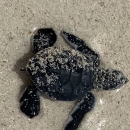A systematic visual survey of the Guam National Wildlife Refuge – Ritidian Unit was conducted from June to July 2017. Two main objectives of this survey were first, to locate existing populations of three species of trees – Heritiera longipetiolata, Psychotria malaspinae, and Tabernaemontana rotensis – and second, assess the habitats throughout the refuge where these threes were thought to exist. 55 hectares of land (550,000m2) on the East side of the refuge was selected as a study site, and approximately 1/5th of the total area was surveyed. Total of 9 T. rotensis individuals were found in two different sites. 5 individuals of H. longipetiolata were found on one site, and no individual P. malaspinae was found. During this survey, 993 individuals of Cycas micronesica were located and relevant data collected. Four major pests that threaten C. micronesica to the verge of ecological extirpation is described in detail here, as evidenced by the pictures taken on site. Biological control agent Rhyzobius lophanthae was not seen during this study period. Collected data may be useful for future conservation effort of C. micronesica, as the plant has been experiencing a serious degree of depredation in number in the recent years.
Publication date
Type of document
Report
Facility
Media Usage Rights/License
Public Domain
Program
Species
FWS Focus
FWS Focus
FWS Focus
FWS and DOI Region(s)


